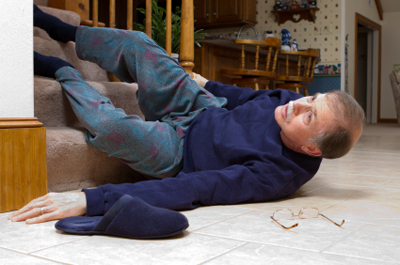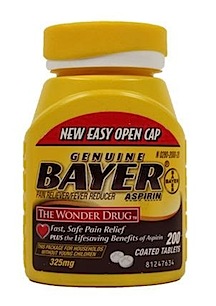If you have an elderly parent or family member in your home, it’s important to know some basic tenets of first aid. The elderly are often more vulnerable to various injuries than younger people, even if they are currently active and vigorous. Here are a few basic first aid skills you should know—and basic health risks particularly relevant to older adults.

Treatment for falls
Seniors are more vulnerable to falls because of reduced motor skills, coordination, muscle strength, and eyesight as common effects of aging. Some medications can cause dizziness or rapid drops in blood pressure that can also put seniors more at risk for falls. And while younger people can also trip and have nasty falls, a senior is much more likely to suffer a serious injury as a result. A single fall can cause a senior who is active and independent to become bed-bound.
If an older loved one suffers a fall, don’t try to help them up right away. Instead, try to assess them for injuries. Talk to the person and try to assess whether they’re injured. If the person is unconscious or appears to be suffering from stroke or a head injury, call 911 immediately and follow the first aid advice from the dispatcher.
If a bone is broken, do not try to reset it. Instead, put some ice in a bag, wrap the bag with a towel, and press it gently to an injured area. Reassure the person and keep them calm and warm until medical help arrives.
If there are no broken bones and the person seems able, help them to get into a seated position with care. Move a chair in close proximity. Help the individual turn onto their side, and from there into a partially seated position. From behind, grip the person’s hips and help them to a kneeling position, using the chair as support. Once kneeling and grasping the chair with both hands, the person should move their stronger leg to get up and onto the chair.
Once in a comfortable position, take stock of the person’s health. Try to determine why they fell—if it was due to a loss of consciousness, this may be a sign of a more serious health problem. Check limbs for injuries, and ask if the person is feeling dizzy or nauseous. Call 911 if there are any causes for concern.

Treatment for cuts
Skin becomes more delicate as it ages, making it more susceptible to scratches and cuts. These can be superficial or quite serious. Superficial cuts should be cleaned and treated with antibiotics; sometimes, these heal quicker when exposed to the air rather than covered with a Band-Aid.
Deeper cuts, however, need more serious treatment. If a cut is bleeding, you can help by placing a clean cloth or sterile bandage over the wound and applying pressure. Elevate the injured limb above the heart to reduce the bleeding further. If the wound appears deep or won’t stop bleeding, call 911.

First aid for heart attacks
Heart attacks can manifest as a feeling of tightness or pain in the chest or upper abdomen that can spread into areas such as the shoulders, arms, neck, or jaw; dizziness and lightheadedness; nausea; shortness of breath; or sweating. Some people who have heart attacks experience no pain, however.
If you believe someone you love is having a heart attack, call 911 immediately. The dispatcher will most likely have first aid instructions for you to follow until medical help arrives; it is important to follow these directions first.
Aspirin can be helpful to people having heart attacks, unless that person has an Aspirin allergy or has been told by a doctor not to take it. Nitroglycerin is often prescribed for people at risk of heart attacks, and can be taken as directed in the midst of a heart attack.
If the person is unconscious, the 911 dispatcher may instruct you to start CPR.
Know CPR for the elderly
CPR is a basic first aid tool that can be crucial to survival, especially for a person suffering from cardiac arrest. Using the heel of your dominant hand or both hands placed one on top of the other, press sharply into the person’s breastbone, approximately in line with the person’s nipples. If you are on the phone with a 911 dispatcher, you will get instructions; most people who are not CPR-trained are instructed to skip rescue breathing and just use chest compressions.
Providing CPR to the elderly is a somewhat controversial topic. CPR can be a fairly violent technique, and with good reason; while you are performing CPR, you are essentially acting as the person’s heart, manually moving their blood through their veins and supply oxygen to their brain. It is important to provide the necessary force when you perform the technique. Because the bones of elderly people are more brittle, they often have greater issues withstanding the force of CPR. However, the patient will most certainly die if they do not receive CPR during a cardiac arrest, and most healthcare providers agree that it is better to survive with broken bones than to die without them.
Even so, taking a full CPR course can help you learn more specific techniques to lessen the damage. If you are caring for an elderly adult in your home, getting CPR training is highly encouraged because of the additional complications that are possible.

Know how to prevent sunstroke, sunburn, and exposure
Elderly people are more vulnerable to fluctuations in temperature, especially those with chronic illnesses. Seniors going outside should always wear sunscreen, no matter whether it’s hot or cold outside. If it’s cold, it’s essential that they wear enough layers to protect all of their skin from exposure. If it’s hot, they will need to stay hydrated and protect their skin from the sun.
Even active elderly people have vulnerabilities that younger people don’t have. It’s important to be aware of the types of dangers an elderly person is particularly susceptible to, and know the basics for how to keep them safe and stable in case of an accident or problem until help arrives. CPR courses are also an excellent idea and worth looking into.



